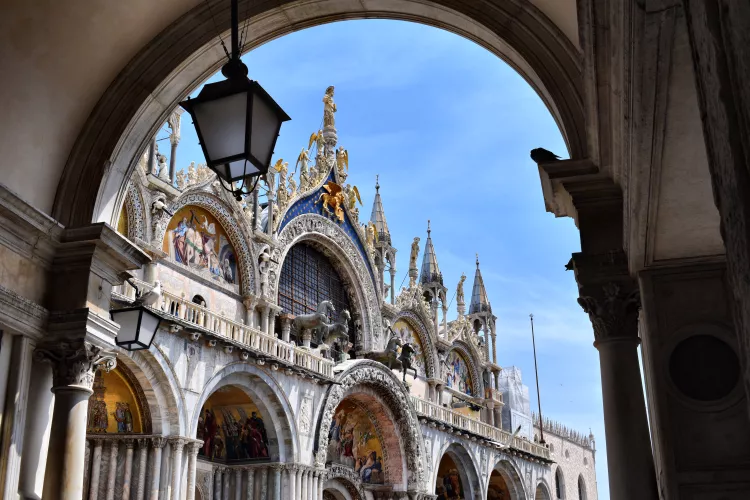With its assorted architectural features, including five domes, turrets, multicolored columns, and sparkling mosaics, Saint Mark’s Basilica in Venice is a jewel box of a building both inside and out. Along with the Doge’s Palace, Basilica San Marco serves as the ornamental focal point of Piazza San Marco and one of Venice’s must-see attractions.
Construction on Saint Mark’s Basilica began in the early- to mid-9th century when Venice was a powerful seafaring city-state known as the Republic of Venice. The current church, completed between the 11th and the 13th centuries, incorporates design elements from Romanesque, Gothic, and Byzantine styles, consequently giving Saint Mark’s its unmistakable look.
What to See on the Exterior
The first view of the ornamental exterior of Basilica San Marco can be overwhelming, especially if approached from its main entrance (its western façade). Columns, cupolas, statues, and touches of gold in its decorated portals and on the church’s many turrets vie for the viewer’s attention. Here are some of the main exterior features to look out for:
- Multi-colored columns: Marble columns of many hues and patterns stacked in double colonnades decorate the façade of Saint Mark’s. These columns originate from all over the Eastern Mediterranean, where the Republic of Venice dominated for centuries.
- Main Portal: The basilica’s central portal consists of three arches which tell the tale of the church’s architectural styles. The inner arch is Byzantine and depicts reliefs of flora and fauna. The Gothic and Romanesque middle arch shows allegories of the months and virtues. The outermost arch is carved with representations of each of Venice’s guilds. The mosaic of “The Last Judgment” above the portal was added in 1836.
- South Façade: The south façade is the one that visitors first see when arriving in Venice by boat. Of note here are two square columns purportedly from a church in Constantinople that was looted during the Fourth Crusade, along with a 4th-century red porphyry sculpture – The Tetrarchs – depicting four joint rulers of the Roman Empire.
- Mosaic of Porta di Sant’Alipio: This is the only surviving 13th-century mosaic on the basilica’s exterior. Located at the northern entrance of Saint Mark’s, the glistening mosaic tells the story of the transfer of Saint Mark’s relics to the Basilica San Marco.

What to See on the Interior
- Interior Mosaics: Saint Mark’s five cupolas are adorned with spectacular Byzantine mosaics, which date from the 11th to the 13th centuries. The dome mosaics depict “The Creation” (in the narthex); “The Ascension” (central dome); “The Pentecost” (western dome); “The Life of Saint John” (northern dome); and “Saint Leonard,” which also includes Saints Nicholas, Blaise, and Clement (southern dome). Rich mosaics also decorate the apse, choir, and multiple chapels.
- The Tomb of Saint Mark: Relics and parts of the body of Saint Mark are buried in his tomb behind the high altar.
- The Baptistery: To the right of the aisle, the richly ornamented Baptistery was built in the early 14th century. Scenes depicted in the Baptistery mosaics include the childhood of Christ and the life of John the Baptist.
- Iconostasis: Common to Byzantine churches, this marble rood screen (partition separating laity from the high altar) is made of gorgeous polychrome marble, topped with a large crucifix and statues of the apostles dating from the late 14th century.
- The Pala d’Oro: This golden, jewel-encrusted altarpiece was first commissioned in 976 and completed in 1342. It depicts the life of Christ and features plaques of Empress Irene, the Virgin Mary, and Doge Ordelaffo Falier (whose original likeness of Emperor John Comnenus was altered to resemble him). An extra fee is required.
- The Treasury: Booty from the Crusades, including jewels, reliquaries, and Byzantine and Islamic art, is kept in the Treasury, a series of ancient rooms between the basilica and the Doge’s Palace. An extra fee is required.
Saint Mark’s Museum
The Museo di San Marco, accessed from stairs by the porch of the basilica, holds Persian carpets, liturgies, fragments from mosaics, tapestries, and other church treasures. Most importantly, the bronze Horses of San Marco, obtained from Constantinople during the Fourth Crusade, are housed in the museum. An extra fee is required.
Editor’s Note: This article was updated by Martha Bakerjian.





